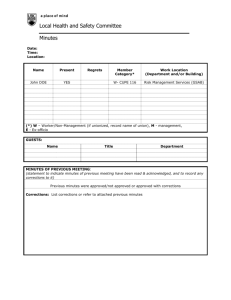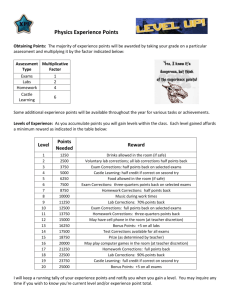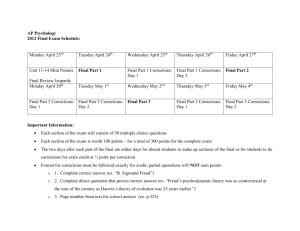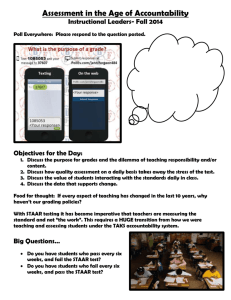Recombinant DNA class Guest Lecture
advertisement
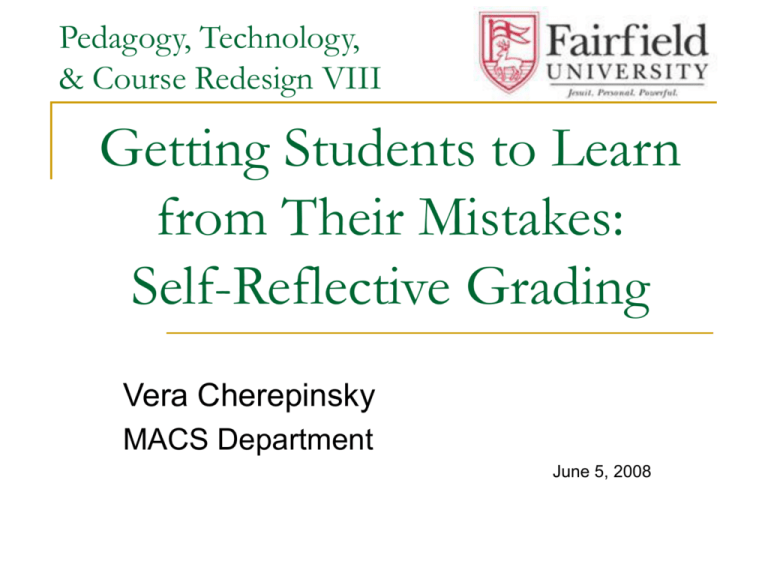
Pedagogy, Technology, & Course Redesign VIII Getting Students to Learn from Their Mistakes: Self-Reflective Grading Vera Cherepinsky MACS Department June 5, 2008 Outline Setting Motivation Source Logistics Results Conclusion Setting & Motivation Fairfield University Jesuit university in Fairfield, CT Founded in 1942 Offers several Masters degrees (including math) Undergraduate enrollment: about 3200 students In introductory math courses, students rarely use graded exams to study Source Article in Conversations on Jesuit Higher Education, No.27, pp17–20, 2005. Incorporating Reflection – one of the Ignatian pedagogy principles – into the math classroom. Intriguing idea: a method of grading requiring students to “review their graded exams, get help on what went wrong and re-submit their corrections.” After thinking through logistics, I decided to implement this idea in my intro calculus classes (MA122 in Sp’06 and MA125/126/227 in ’06-’07 AY) Logistics: General Idea Exams first returned without comments or grades Each problem marked with or X , if completely correct X, if there is some error in the solution May be a serious mistake, or something very minor in the correct solution Students get detailed directions on what to do to “get points back” They have a week to go over their exams and must resubmit original exam with a set of corrections Logistics: Corrections Rules For each problem marked with X, Find all errors made (may be more than one!) For each error Decide whether it was major or minor and explain why, and Show how to fix it. On due date, both original exam and corrections are collected from each student and graded together. Each problem on original is assigned a grade (with partial credit). For each error correctly identified, classified, and fixed, the student gets back half the points lost on it. Logistics: Sample Directions MA126 Exam 2 Corrections: Due Wednesday, 4-25 Marked exams were returned in class on Wednesday. An "X" next to a problem indicates there was some error in the solution. It may be a serious mistake, a question left unanswered, an unjustified claim, or something very minor in the mostly-correct solution, such as a typo in the explanation. (If the only thing wrong was clearly a typo or an incorrect notation, this was indicated with a check-mark with a small slash through it; otherwise, something else is wrong as well.) Note also that there may be more than one error per problem, so check your ENTIRE solution to make sure you found them all. Also, don't be discouraged if you didn't get any of the problems completely right: it may just mean you made a minor error in each one. CORRECTIONS (on separate sheets of paper -- DO NOT write on the original set of exam solutions!): For each problem marked with an "X", you must 1) find the error(s); and for each error, 2) decide whether it is major or minor (and EXPLAIN WHY); and 3) explain how to fix it (for example, you may do this by writing out a correct solution and indicating where you went wrong). Your corrections AND the original exams will be collected back on WEDNESDAY, 4-25. BOTH of these will be graded; for each error you correctly identify, classify, and fix, you will get back up to half the points lost due to making it in the first place. You are welcome to work together, use your books and notes, and come ask me for help if you can't figure out what you did wrong. Note, however, that each of you must hand in INDIVIDUAL corrections to your exam. Logistics: Prior to Exam Explain grading method Make very clear: over-relying on “fixing it later” is a bad strategy Extreme case: originally leaving exam blank and then solving everything perfectly to hand in as “corrections” earns at most 50% (an ‘F’) Other extreme: not doing any corrections at all (just returning original) is equivalent to traditional grading Logistics: Instructor Side Marking original exam Grading corrections Keep track of how far each student got on each problem (to distinguish original vs. corrections work) If all conditions are satisfied, half lost points are returned Total grade Show both grades for each problem Marking Exam (First-Pass) Grading Sample Total Grade Results: Survey Form Numerical questions 1 (disagree strongly) to 7 (agree strongly) Free-form questions Would you use it again? Y/N/No preference Results Timing Measures student perceptions, hence given right after exams + corrections are handed in, but before a grade is assigned Numerical Data Summary MA227 MA126 Fa’07 Sp’07 (15) (22) 1 (more time) 2 (easy to find) 3 (get it better) 4 (enjoyed) 5 (higher grade) %Y %N %No preference 6.4 4.4 6.3 4.8 6.4 100 0 0 6.4 4.0 5.8 4.6 6.9 95.5 0 4.5 MA125 Fa’06 (28) 6.4 4.1 5.6 4.7 6.2 92.9 3.6 3.6 MA122 E2 MA122 E1 Sp’06 (41) Sp’06 (36) 6.2 3.5 5.4 3.3 5.8 73.2 2.4 22.0 6.5 3.4 5.3 3.8 5.7 55.6 0 36.1 Avg 6.4 3.8 5.6 4.1 6.1 Free-form Questions: Themes #6 (what did you like?) – top responses “Can earn back points/improve grade” Next theme varied by class/semester MA126, MA125, and MA122 E1: “able to go over work & correct mistakes” MA122 E2: “understand material better” Quotes “Not only does it give me a chance to get a better grade, it also ensured that I had a decent grasp of the material” “I like that I had a chance to improve my grade. I also like that this assignment forced me to understand the material.” Free-form Questions: Themes (cont’d) #7 (how to improve?) – top responses MA126 MA125 “good as is” “show how much got wrong (how serious?)” “good as is” “show / go over areas of common mistakes” MA122 “show how much got wrong (how serious?)” “good as is” “give a hint on where errors are (esp in multi-part probs)” Trends & Modifications Made Trends Students who originally do poorly love this Students who were almost right like this less Modifications made First, a typo or notation error got a problem an “X” Based on student comments, since then, a correct solution with a typo gets a “” with a small slash Conclusion Experience of using it over the past 4 semesters and student survey data convinced me that “self-reflective grading” benefits student learning helps develop their self-error-correcting skills Thus, despite the extra time spent on grading, I believe it is an investment well worth its while. Acknowledgements Chris Petersen Black (Central Washington University – Lynnwood) Original idea from her article in Conversations Larry Miners, Economics Dept. and CAE (Fairfield U.) Helped design the survey form Used self-reflective grading in his small upperlevel economics classes Questions? __________________________________ Dr. Vera Cherepinsky Assistant Professor of Mathematics Fairfield University Phone: 203-254-4000 x3089 Email: vcherepinsky@mail.fairfield.edu __________________________________
